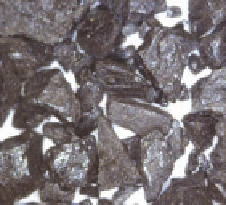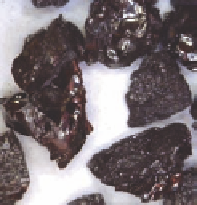Geology Reference
In-Depth Information
11.4. Coal-Fire Residues
Medium volatile bituminous coal (left) and
coke collected from a burning spoils pile at
the Mulga, Alabama Gob Fire.
Photos by Stephen Emsbo-Mattingly, 2009.
Semivolatile Hydrocarbons
T
his section presents source signatures for various groups of extractable semivolatile hydrocarbons from unheated
native bituminous coals, carbonized coal residues, and coal by-products. These residues (semicoke or coke) and
by-products (tar) were produced naturally and industrially, which are compared and contrasted in the following
discussion. The first set of samples represents the transformation of native coal beds associated with the Ruth
Mullins coal fire in Perry County, Kentucky (Volume 3). The Ruth Mullins fire occurs in the Hazard No. 7 coal bed
in the Pennsylvanian Breathitt Formation. These samples include the unburned native coal, the carbonized coal
residues from burned areas of the seam, and liquid coal tars expelled from surface seeps near the fire. The second
set of samples represent the transformation of coal in a coke oven and coal distillation apparatus under controlled
conditions typical of historic manufactured gas production and modern metallurgical coke production (Emsbo-
Mattingly et al., 2003b). Comparing various hydrocarbon signatures from natural and industrial processes is useful
in identifying the possible thermal and environmental effects at coal-fire sites.
Dominant Hydrocarbons
T
he thermal transformations affecting coal and its by-products at coal-fire sites result from the complex interaction
of the coal matrix and various factors including temperature, oxygen levels, residence time, and catalytic surfaces.
Despite the large number of contributing factors, the character of the semivolatile hydrocarbons produced by these
transformations is fairly consistent within a contiguous coal-fire area and around coal carbonization plants. For
example, the Ruth Mullins coal fire involves high-volatile bituminous coal in the Breathitt Formation (Volume 3).
The primary extractable semivolatile hydrocarbons in this raw, uncombusted coal from the Hazard No. 7 coal bed
include alkylated naphthalenes, plant waxes, and a wide, late eluting UCM (Figure 11.4.1A). The effect of thermal
exposure on the extractable hydrocarbons is evident in samples of carbonized coal within the coal-fire area and coal
tars collected from surface vents. The first sample of partially carbonized coal (site 1) contains three- to six-ring
pyrogenic PAHs and a late eluting UCM (Figure 11.4.1B). The second sample of carbonized coal (site 2) contains
predominantly four- to six-ring PAHs and a late eluting UCM (Figure 11.4.1C). The greater depletion of two- and
three-ring PAHs in the site 2 compared to the site 1 sample indicates that the coal from site 2 experienced a greater
degree of thermal stress than the coal from site 1. The relative abundance of four- to six-ring PAHs in the
carbonized coal from site 2 may reflect hotter temperature, longer residence time, or more exposure to catalytic
surfaces leading to a greater degree of carbonization.
The coal-tar residues from surficial vents also exhibit variable hydrocarbon signatures. The coal-tar sample from
vent 1 contains predominantly four- to six-ring PAHs and a late eluting UCM (Figure 11.4.1D). The vent 1 tar
sample resembles the carbonized coal from site 2, which indicates that the dominant hydrocarbons in the
carbonized coal from site 2 consist of coal-tar residues that were not expelled from the carbonized coal. A
second coal-tar sample from vent 5 consists of two- to six-ring pyrogenic PAHs and a late eluting UCM
(Figure 11.4.1E). The pattern of PAHs in this tar sample indicates two distinct features. First, the four- to six-ring
pyrogenic PAHs and late eluting UCM resemble the vent 1 tar sample. Second, the two- to three-ring pyrogenic
PAHs represent a relatively unweathered coal-tar fraction that likely formed due to condensation of volatile vapors
produced from the coal fire. Collectively, the source signatures of the extractable hydrocarbons in both carbonized
subsurface coals and coal tars found at surface vents from the Perry County coal fire, indicate the widespread






